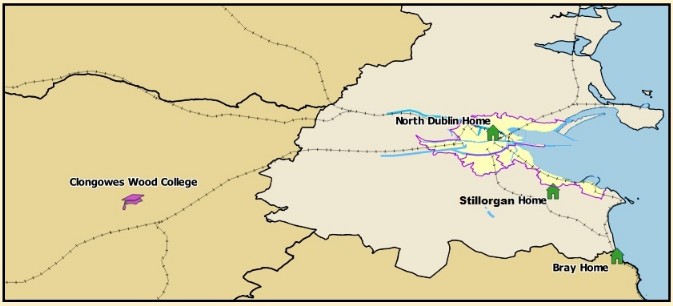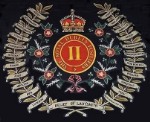Clongowes Wood College

Colorized Photo, Great Southern & Western Railway Travel Booklet, c. 1898.
From September 1888 through June 1891, James Joyce attended Clongowes Wood College, an elite Jesuit boarding school for boys founded in 1814. At the time, the school was Ireland's premier private school for children of middle and upper class Catholic families. St. Columba, Co. Dublin, was the Irish school of choice for moneyed Protestants. When Joyce was at Clongowes, the annual fee was £42. Additional annual charges for books, laundry, equipment, etc. came to £6 3s. Instruction in music, dancing, and art cost extra. Click here for the school's prospectus for 1886. It is in a pdf on this website and will open in a popup window. Note that the fees are stated in guineas (each representing 21 shillings), which is how the cost of goods and services.
Schooling at Clongowes was expensive. The annual, all-in cost (including music and art) was £56 13s. This was a substantial sum as at the time, the annual wage in Dublin of a skilled, construction worker was £60 - £100. For the 2021/2022 school year, cost of attendance was €20,800. That fee "excludes items such as school books, sports equipments, trips, art supplies, medical expense, uniforms, laundry, music tuition, etc." Note that Ignatius Loyola, who founded the Society of Jesus in 1534 and was canonized in 1622, had strictly forbidden that fees should be charged for anything but room and board. Clongowes was allowed to charge tuition fees through an 1833 dispensation of the Jesuit Superior General.
At the time Joyce attended, the school was open to boys aged 7 to 16 with the younger pupils in a junior division where they received primary schooling. An exception was made for young James who entered at age six and one-half. Currently, the full course at the school is six years and boys enter at age twelve.
Location of Clongowes Wood (Clane, Co. Kildare)

When Joyce entered Clongowes, the family lived in Bray. As the family fortune declined, the Joyces moved to progressively less desirable locations. After living in Bray, the family moved to Stillorgan in Co. Dublin, then Drumcondra, just north of the Dublin city limits. By Bloomsday, Drumcondra had been incorporated into the City of Dublin.
Old Clongownians include Oliver St. John Gogarty (noted Irish surgeon, politician, and man of letters; "friend" of James Joyce and model for Buck Mulligan), Tom Kettle (noted Irish nationalist and academician; friend of Joyce for twenty years), John Redmond (noted Irish nationalist and political idol of John Stanislaus Joyce), Redmond's son William, and John Charles McQuade (politically influential archbishop of Dublin and in the post World War II era, the "keeper of Ireland's morals" under Fianna Fail governments). The character Stephen Dedalus, in both Ulysses and A Portrait of the Artist as a Young Man, is an Old Clongonian.

Irish Catholic Directory, 1900
The school remains the bastion of old money and in modern times has produced more CEO's of major Irish corporations than any other secondary school in the Republic. Clongowes Wood refused to recognize James Joyce's attendance until well after Ulysses attained critical acclaim. Currently, the school's library is named the "James Joyce Library."
In Late-Victorian Ireland, the other elite, Catholic boarding schools for boys were St. Vincent's College at Castleknock (founded 1835) and The French College at Blackrock (founded 1860). (Click on links for their advertisements in The Irish Catholic Directory, 1900. The pdf will open in a popup window.) Like Clongowes, Castleknock and Blackrock are still thriving. For girls, the elite schools were the Loreto Convent School in Rathfarnham and the Sacred Heart Convent School in Dundrum. The Loreto School closed in 1996. The Sacred Heart School is now known as Mount Anville Secondary School, a day-school operated by the Mount Anville Sacred Heart Education Trust. Queen Victoria, during her 1900 visit to Dublin, called on both girls' schools, as well as Castleknock.
n/ Website of Clongowes Wood College, www.clongowes.net; Ciaran O'Neill, Catholics of Consequence (Oxford: Oxford Univ. Press, 2014); Michael J.F. McCarthy, Five Year's in Ireland, 5th Ed. (Dublin: Hodges, Figgis, 1901), 493-500; Clongowes Wood Prospectus, 1886; Louis McRedmond, To the Greater Glory: A History of the Irish Jesuits (Dublin: Gill, 1991), 158-60.
Links to Other Websites
Note: The webpages will open in new browser windows.
Brendan Cullen, A Short History of Clongowes Wood College (Clane, IE: Cullen, 2011). Cullen taught at Clongowes for 36 years. Posted on the school's website.
By Harman Murtagh (Clane, IE: Conglowes Wood College, 2014). On the web publishing platform Issuu.
Photographs on Other Websites
These links lead to digital images on other websites. All images are the property of the institutions that created them, and may not be used for commercial purposes without their permission.
Note: The photographs will open in popup windows.
Photograph by Robert French. From the Lawrence Collection at the National Library of Ireland.
John Conmee, Rector, is seated in the front with the rug under his feet. This real Fr. Conmee was Joyce's model for the Jesuit Ulysses' character. From the flickr gallery of the Jesuits in Ireland, Irish Jesuits.
Six-year-old James Joyce is in the light suit, seated front and center. Image on the website of Clongowes Wood College.
In the photo, one of the most famous Old Clongownians speaks to a crowd as part of the school's Union Day events. That day in May marks the graduation of the upper division students (secondary schooling). From the website of Clongowes Wood College.
Photo by Alexander Campbell Morgan. From the website of Clongowes Wood College.
From the website of the Irish Times.


